Other Parts Discussed in Thread: TPS7B4255, INA826, OPA994
Tool/software:
Hello,
I need to supply an adjustable voltage 1.7-2.7V to a PCB at end-of-line test, 3.6VAbs Max. This will come from an offboard bench supply but I want to dummy-proof accidental setting to higher voltages than this. These are super expensive PCBs.
I'm considering a tracking LDO like TPS7B4255 to "buffer" the voltage but the output voltage doesn't go quite this low.
Thought about Power Op-Amps but I'm less certain that OPAs are suitable for this. The PCB has about 100uF of ceramic capacitance.
Max DC current is 5mA, typical is <1mA.
Any ideas how to use OPAs for this? DC buffer, G=1
Thanks!



